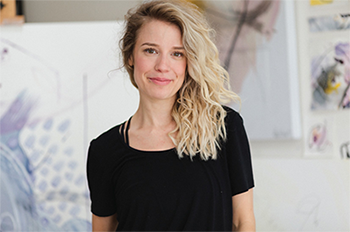Studio Visit with Britni Mara
Take a look at one of Britni Mara’s paintings and and you’ll fall in love with her abstract compositions and brilliant use of color, line and texture. Mara’s use of all natural, home-made pigments and dyes speaks to issues of environmentalism and sustainability as much it points to progress, and a purposeful, mindful approach to creating. An active member of the community, she does her part in promoting the use of these alternative painting materials through collaborations and pop ups throughout the city. Since we have a shared love of sustainability, the earth, and everything it offers us (especially Aronia Berries!), we caught up with Britni to hear more about her life and art.
Ziyad Asrar (ZA): How long have you been painting and when and why did you start incorporating natural pigments into your work?

Britni Mara (BM): I’ve been creating artwork since I was a little kid, but I fell in love with abstract painting in college. I have a very traditional art education and had little experience in conceptual based work. This really allowed me to hone my skills before breaking rules. I graduated from Bradley University with a Bachelor of Fine Arts degree in Studio Art and then I did a semester of Post-Baccalaureate work in Italy at the Siena Art Institute. It was there that I fell in love with a conceptual style of painting, based in an unconventional medium. I took a cultural shift I was immersed in, moved it into my artwork and began painting with makeup. This body of work became a feminist statement, a cultural statement as well as a personal one. That moment, was an eye opener for me. I realized that abstract painting could conceptually stand alone, if the materials I used meant something.
A few years later, my home and work life collided. After a long day of work in the studio, I went to make myself dinner. I went to chop some beets and became annoyed with the stains on my hands and cutting board. I hopped in the shower after a healthy meal and it just dawned on me. Why was I creating artwork with materials that were dangerous to myself and the environment, when the Earth provides us with beautiful pigments? The very next day I started to experiment with drawing color from those very same beets I was using to cook the night before. From there, I moved to cilantro, saffron, turmeric, and berries. That was about a year ago, and I’ve since created a full spectrum of color to use as paint. This body of work is now an environmental statement. It’s a personal statement and a universal one, and I couldn’t be happier with where I am creatively because of it.
ZA: What are some of the benefits of using natural pigments? Are there limitations or considerations that inform how you use them in your work?

BM: I think the biggest and best benefit is knowing you are not creating any more unnecessary waste in the world. Street art, resin, and acrylic paintings are gorgeous but all of them harm the environment in some way. They also aren’t great for the artists using them. Here’s another big pro—they’re extremely affordable. A little time consuming to create, and have a little bit of a shorter shelf life, but they’re so cheap, and go so far.
There are a few limitations. Since I don’t use any chemical bonding agents the paintings aren’t lightfast. This means they may fade and change over time. I always tell people that invest in my work that they are investing in a concept, rather than a physical piece of artwork. Purchasing work from me means having art in your home that will start a conver- sation about environmentalism, and that is all that really matters to me.
I also miss the opacity and viscosity of acrylics. There’s nothing quite like it. The natural paints are all water-based so they are very translucent. It’s definitely a different mindset of creation.
ZA: What is the process like for making natural pigments and dyes? What kind of materials, plants, fruits etc… can be used? Can someone do this at home and if so are there specific tools, equipment or resources (books/web- sites etc..) that they should check out?

BM: The process is pretty simple, hot water and a strainer. If you’re using whole fruits or veggies I recommend using a high speed blender, and then straining. Once you have your color derived, put it in an airtight jar and keep it in the fridge to ex- pand its shelf life. I use all sorts of things, some of my favorites are butterfly blue pea flower, aronia berries, beets, hibiscus flower, saffron, turmeric, and avocado pits. The list is really endless though.
There are a ton of fabric artists working in this natural medium and they use things like onion skins, black beans, flower petals, red cabbage, pomegran- ate rinds, cherries and so much more. I bought Maggie Pate’s “The Natural Colors Cookbook” a few months in to my own experimenting. While her work is based on fabric dying, many of the same rules apply and it was a really helpful tool.
ZA: Are there other artists using natural pigments that you admire? Do you see growing interest in these methods/ techniques among other artists?
BM: There aren’t very many other visual artists working in the same way that I am, so I’ve had to make up some rules along the way, but that’s part of the fun I think!
I have definitely seen an uptick in interest in this sort of work and that is really what brings me joy. I want people to take this concept and run with it. I would love to bring art back to the basics of illuminating the natural beauty around us. Starting a conversation is all an artist can ask for.
MORE BRITNI MARA
Insta: @britnimara
Web: www.britnimara.com
